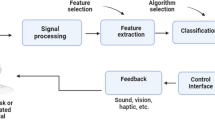Abstract
This study was aimed at analyzing features of the closed feedback loop principle for human endogenous rhythms in two perspective technologies of neurointerfaces, which are neurofeedback and adaptive neurostimulation. Based on our experimental data, the main advantages of the adaptive neurostimulation approach have been validated, namely, automatic closing of the feedback loop of human endogenous rhythms and involvement of the processes of perception and processing interoceptive signals in the mechanisms of brain activity that contribute to normalization of the functional state during stimulation procedures.
Similar content being viewed by others
REFERENCES
N. R. Provenza, E. R. Matteson, A. B. Allawala, et al., Front Neurosci. 13, 152 (2019).
R. Sitaram, T. Ros, L. Stoeckel, et al., Nat. Rev. Neurosci. 18 (2), 86 (2017).
F. Riganello, V. Prada, A. Soddu, et al., Int. J. Environ. Res. Public Health, 16 (13), 2336 (2019).
S. Haegens and E. Z. Golumbic, Neurosci. Biobehav. Rev. 86, 150 (2018).
V. C. Goessl, J. E. Curtiss, and S. G. Hofmann, Psychol. Med. 47 (15), 2578 (2017).
V. Deschodt-Arsac, R. Lalanne, B. Spiluttini, et al., PLoS One 13 (7), e0201388 (2018).
P. Lehrer, K. Kaur, A. Sharma, et al., Appl. Psychophysiol. Biofeedback, 45 109 (2020). https://doi.org/10.1007/s10484-020-09466-z
O. Jafarova, K. Mazhirina, E. Sokhadze, and M. Shtark, Appl. Psychophysiol. Biofeedback 45 (2), 87 (2020).
A. Zaccaro, A. Piarulli, M. Laurino, et al., Front. Hum. Neurosci. 12, 353 (2018).
J. Blum, C. Rockstroh, and F. S. Goritz, Appl. Psychophysiol. Biofeedback 45, 153 (2020). https://doi.org/10.1007/s10484-020-09468-x
I. V. Nuidel’, A. V. Kolosov, V. A. Demareva, and V. G. Yakhno, Sovrem. Tekhnol. Med. 11 (1), 103 (2019).
E. Dessy, O. Mairesse, M. van Puyvelde, et al., Front. Hum. Neurosci. 14, 22 (2020).
D. Valeriani, C. Cinel, and R. Poli, Brain Sci. 9 (2), 22 (2019).
A. I. Fedotchev, Biofizika 41 (3), 718 (1996).
T. Oxley and N. Opie, World Neurosurg. 122, 415 (2019).
X. Zhou and J. P. Miller, Neurosurgery 85 (3), E440 (2019).
M. C. Lo and A. S. Widge, Int. Rev. Psychiatry 29 (2), 191 (2017).
B. Yu, M. Funk, J. Hu, and L. Feijs, Behav. Inform. Technol. 37, 800 (2018). https://doi.org/10.1080/0144929X.2018.1484515
C. L. Tegeler, H. A. Shaltout, S. W. Lee, et al., Glob. Adv. Health Med. 9, 2164956120923288 (2020).
S. Cheung, E. Han, A. Kushki, et al., Front. Neurosci. 10, 401 (2016).
T.A.Deuel, J.Pampin, J.Sundstrom, and F.Darvas, Front. Hum. Neurosci. 11, 213 (2017).
S. K. Ehrlich, K. R. Agres, C. Guan, and G. Cheng, PLoS One 14 (3), e0213516 (2019).
A. I. Fedotchev, V. M. Kruk, S. J. Oh, and G. I. Semikin, Int. J. Industr. Ergonomics 68, 256 (2018).
A. I. Fedotchev, Biophysics (Moscow) 64 (2), 268 (2019).
A. I. Fedotchev, S. B. Parin, K. N. Gromov, et al., Zh. Vyssh. Nerv. Deyat. 69 (2), 187 (2019).
A. I. Fedotchev, S. B. Parin, and S. A. Polevaya, Vestn. RFFI. Obshchestv. Gumanit. Nauki, No. 1, 144 (2019).
L. Quadt, H. D. Critchley, and S. N. Garfinkel, Ann. N. Y. Acad. Sci. 1428 (1), 112 (2018).
O. R. Dobrushina, L. A. Dobrynina, G. A. Arina, et al., Zh. Vyssh. Nerv. Deyat. 70 (2), 206 (2020).
S. S. Khalsa, R. Adolphs, O. G. Cameron, et al., Biol. Psychiatry Cogn. Neurosci. Neuroimag. 3 (6), 501 (2018).
Funding
The work was supported by Russian Foundation for Basic Research, grant nos. 18-013-01225 and 19-013-00095.
Author information
Authors and Affiliations
Corresponding author
Ethics declarations
COMPLIANCE WITH ETHICAL STANDARDS
The paper does not describe studies involving human or animal subjects.
CONFLICT OF INTERESTS
The authors declare no conflict of interests.
Additional information
Translated by A. Deryabina
Abbreviations: EEG, electroencephalogram.
Rights and permissions
About this article
Cite this article
Fedotchev, A.I., Parin, S.B. & Polevaya, S.A. The Principle of a Closed Feedback Loop of Human Endogenous Rhythms in Modern Neurofeedback and Adaptive Neurostimulation Technologies. BIOPHYSICS 66, 349–351 (2021). https://doi.org/10.1134/S0006350921020056
Received:
Revised:
Accepted:
Published:
Issue Date:
DOI: https://doi.org/10.1134/S0006350921020056




